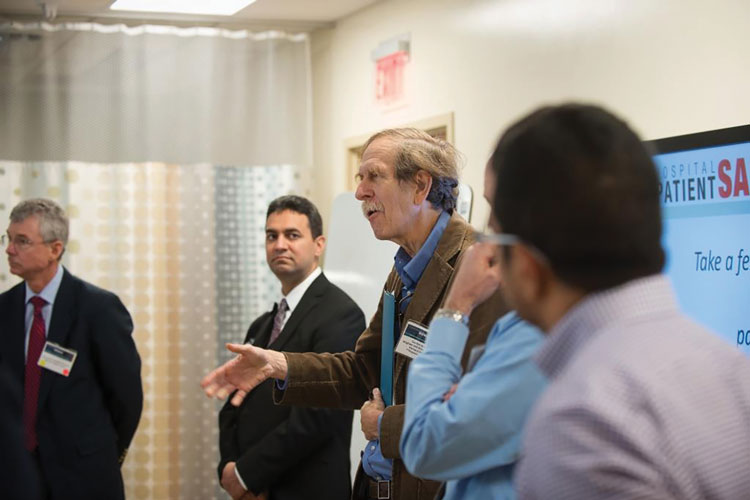Fundamentally Human: Learning By Design
Dr. Schiff participated in one of the simulation sessions, facilitating a small group discussion of the case. “Some of our best weapons for ‘forward-looking’ accountability and safety are sharing (of adverse events and errors), simulation (as I witnessed in their center), and safety nets (to mitigate and protect against inevitable errors). All of these things are just beginning to be used, applied, and understood,” he said. “This simulation center, and the entire team behind it, is clearly on the forefront, and more research in these areas is intensely needed.” (Figure 2)

An additional topic of focus was human factors and the potential impact on errors in healthcare. Multidisciplinary teams were again assigned to rooms in the simulation center where they encountered a 72-year-old patient who was recovering from a knee replacement surgery earlier in the day—portrayed by a sim mannequin—and the patient’s sister, a live SP. The teams were pre-briefed with the clinical scenario and provided the following objectives:
Assess the patient for pain and discomfort
Identify the errors/unsafe conditions in the room
Identify human factors that may have contributed to the errors/unsafe conditions
Submit ONE list to the facilitator
What the teams were not told was that the simulation included an intentional distraction to hinder them from completing their objectives. As the teams entered the room, they found the moaning “patient” and his very angry sister. She was distraught over the patient’s pain level, over-protective, and blocking access to the patient. A myriad of errors were present in the room (wrong patient ID band, expired IV fluids, etc.) for teams to identify, but first they had to interact appropriately with the sister to gain access to the patient.
Team reactions to this simulation varied. Some had members who were very skilled at de-escalation and able to communicate with the sister effectively. But other teams did not respond as well, which was a surprising outcome to the exercise. During the large-scale group debrief, a resident physician acknowledged he felt ill-prepared for dealing with the sister, and did not know how far to “push it” with her. He added that in real life, he would have been more likely to be forceful, possibly even calling security, to allow him to assess the patient.
Outcomes 2015
Following the event, participants were asked to provide feedback through a survey, and results were very positive. Attendees valued the collaborative nature of team-based learning and the importance of communication. Additional feedback reflected awareness that provider interaction with technology and equipment can create a barrier to developing a good relationship with the patient and family.
Opportunities for improvement included the need for more concise communication around the goals and objectives for the human factors simulation during the pre-briefing. There were several comments from attendees indicating they were unsure of what they were supposed to do—interact with the sister, find the errors; or care for the patient?—which may have contributed to some of those fundamentally human responses observed during the simulations. This lack of clarity likely created some unintended frustration among attendees. Other comments included the need for individual team debriefs directly following the simulations, to allow for immediate feedback, clarification, and validation.
As the planning team met to review the evaluations, it was obvious that immediate debriefs were vital to the simulation process, along with clear objectives for the simulation breakout sessions. These areas became priorities for improvement as the team began to design the next symposium.
